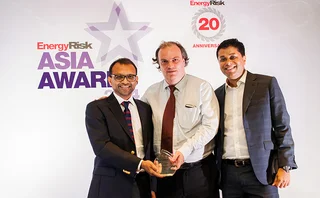
The metals bubble
After a virtually non-interrupted two-year bull run, metal prices have dropped sharply from their highs last May. Jayne Jung reports on how investors have reacted to the change in conditions
Metals prices have been on a sharp upward trajectory over the past few years, with some sectors reaching record highs last May. These markets have historically been dominated by a relatively small number of players - mining companies, specialist trading firms and brokers. However, the rise in prices has attracted a greater variety of institutional investors into the markets, including hedge funds and pension funds.
In fact, a number of analysts claimed the record high prices achieved last year were driven partly by the participation of these players, combined with the massive inflows from passive index investors. These participants, they argue, entered the markets to cling to the coat-tails of rising prices, which in turn drove asset values higher (Risk July 2006, pages 20-25). And some predicted these investors would pull out as quickly as they entered these markets if prices started to fall.
"The majority of market participants must be aware that they are participating in the inflation of a bubble. This awareness does not, for all that, dissuade them from continuing to buy, taking into account their hopes for gains in the very short term. However, they are ready to take their profit at the least sign of a trend reversal since they know that the potential decline is, by definition, considerable," wrote the authors of a Societe Generale research report, published in May 2006.
Since the publication of that report, metals prices have fallen sharply. Copper prices on the Comex division of the New York Mercantile Exchange dropped to $2.48 a pound on January 18, from a 10-year high of $4.08 a pound on May 23, 2006. The active-month copper futures contract for three-month delivery on the London Metal Exchange (LME) fell by 36% from $8,600 a tonne on May 11, 2006 to $5,540 on January 18 (see figure 1). Aluminium also fell from $3,185 a tonne to $2,695 a tonne over the same period.
Even before the fall in prices, there were some high-profile casualties. New York-based Ospraie Management, a commodity-specialist hedge fund, believed copper prices had reached their highs in early 2006 and took a large short position. Instead, prices continued to rise. By June last year, the fund had taken a 29% hit and was forced to close its $250 million flagship Ospraie Point Fund. Also New York-based, Touradji Capital Management is believed to have been one of the investors on the other side of Ospraie's short positions. The fund's founder, Paul Touradji, declined to comment on how the recent fall in prices has affected its performance.
There have been no other reports of hedge funds suffering losses, but uncertainty over the direction of prices has prompted a number of funds to sit on the sidelines in recent months, say analysts. "There's a lot of caution from the discretionary hedge fund community. The problem is that prices have fallen a fair distance from the 2006 peak, but copper prices are still not far below $6,000 a tonne and that's historically still a very high price for copper," says Kevin Norrish, a director in the commodities research team at Barclays Capital in London. "Discretionary traders think that, at current price levels, the upside risk is maybe not worth it. There are other, more attractive, opportunities within the base-metal sector and in other commodity sectors."
Not all investors are taking a wait-and-see approach, however. Some hedge funds are taking long positions further out along the curve, amid expectations that prices will once again start to climb as a result of low inventories and a resurgence of demand from China.
"Our view is that the sell-off we've seen broadly across the metals markets was not really justified by any significant change in supply and demand fundamentals," says Norrish. "For copper, specifically, this will be a year where we see the gap between demand and supply shrinking, but there is unlikely to be a build-up of huge levels of excess inventory. The market will remain vulnerable to supply disruption and resulting price spikes."
Many hedge funds agree with this view, but are sidestepping any uncertainty in the medium-term by going long 2008-2010 contracts, say analysts. At the front end of the curve, some hedge funds are shorting the copper market. According to the Commodity Futures Trading Commission, non-commercial investors held a net short position of 20,627 contracts as of January 16, compared with a net long position of 2,256 contracts at the same time last year.
Barclays Capital's Norrish believes this phenomenon is another reason why copper prices may move upward in the near future. "There is a very large speculative short position that needs to be covered. That in its own right could give us a fairly swift move up in price," he says.
Interest in taking large, one-way directional bets, however, has waned. One popular alternative is a relative value trade based on whether one base metal can substitute another in manufacturing or home-building. For example, investors are shorting copper and going long aluminium because aluminium is a natural substitute for copper in certain circumstances. "Physically, aluminium can be used for power transportation and cabling. Because the price of aluminium relative to copper is high, there has been some displacement. People have preferred to use it because it is more cost-effective from a start-up point of view," says Jeremy Weir, London-based chief executive of the $200 million Galena Asset Management fund. After May's high, aluminium fell to $2,426 a tonne on September 15, 2006, then rose to $2,695 on January 18.
Baseless
Mo Ahmadzadeh, New York-based president of specialist commodity trading firm Mitsui Bussan, believes the philosophy underpinning these relative value trades may prove baseless. "With most of these metals, their primary applications - corrosion resistance of zinc, the conductivity of copper and the lightness of aluminium - lend themselves to very specific, and not so penetrable, uses from a substitution perspective," he explains. He points to roofing as a specific example of substitution. "You can move from copper roofs - where prices have severely handicapped this application - to aluminium roofs with a copper patina. But, to do the fundamental calculations behind it is not practical in terms of an investment. It's tough to make the fundamental argument for these relative value trades."
Another popular relative value trade is going short copper and long nickel, based on a comparison of production and consumption figures. "Copper has pulled back from cyclical highs, but nickel continues to set at all-time highs. To some degree, that's due to funds willing to take a bet about how tight supply and demand is," says Mark Liinamaa, New York-based metals and mining analyst in equity research at Morgan Stanley. Since May 2006, three-month nickel prices on the LME have jumped 99% - from $19,000 a tonne on May 2, 2006 to $37,800 a tonne on January 23. However, dealers stress that a deep knowledge of the underlying markets is vital to implement strategies such as these.
While some hedge funds may be looking to take advantage of current price dynamics by switching strategies, other institutional investors have, for the most part, kept hold of existing positions. The pensions sector, for instance, has significantly increased its exposure to commodities in recent years to try to diversify portfolios away from equity and fixed-income investments. These investors are taking a long-term view of the markets, and have not been daunted by the recent drop in prices, say analysts. "It's a minimum of 10-15- or 20-25-year investments, so it's not really an issue for those who are already invested. It's probably an issue for those considering an investment in commodities or those who want to add to existing commodity investments. I think the idea is that commodity indexes are not the way to go right now," says Barclays Capital's Norrish.
Stephen Briggs, a London-based metals analyst at Societe Generale Corporate and Investment Banking, agrees that investors are thinking twice about investing in commodity indexes in the current environment. "Long-term investors are still entering the market based on decisions made many months in advance. But you could lose a fortune if you time it wrong. It's the same as what happened in the internet bubble," he says. "Those who entered the commodities market in August last year have lost a lot, because commodities that are doing well - like tin - are a much smaller market than oil and energy. Salespeople will tell you it's a great investment because it's non-correlated with equities. But we all know that is spurious, and you can't convince someone that losing money is good investment."
Only users who have a paid subscription or are part of a corporate subscription are able to print or copy content.
To access these options, along with all other subscription benefits, please contact info@risk.net or view our subscription options here: http://subscriptions.risk.net/subscribe
You are currently unable to print this content. Please contact info@risk.net to find out more.
You are currently unable to copy this content. Please contact info@risk.net to find out more.
Copyright Infopro Digital Limited. All rights reserved.
You may share this content using our article tools. Printing this content is for the sole use of the Authorised User (named subscriber), as outlined in our terms and conditions - https://www.infopro-insight.com/terms-conditions/insight-subscriptions/
If you would like to purchase additional rights please email info@risk.net
Copyright Infopro Digital Limited. All rights reserved.
You may share this content using our article tools. Copying this content is for the sole use of the Authorised User (named subscriber), as outlined in our terms and conditions - https://www.infopro-insight.com/terms-conditions/insight-subscriptions/
If you would like to purchase additional rights please email info@risk.net
More on Metals
Interview: Can Matthew Chamberlain rescue the LME?
London Metal Exchange CEO identifies problems, awaits contract and fee structure revamp feedback
Base metals dealer of the year: BNP Paribas
French bank expands hedging and finance solutions to mainland China
Asia precious metals house of the year: Citi
Citi builds full-service Asia strategy as others exit market
LME Clear ‘welcomes scrutiny’ of CCP risk management
Oversight from clearing members is good for central counterparties, says LME Clear CEO
Metals house of the year: SG CIB
Barclays and Jefferies Bache deals highlight bank’s commitment to metals
Metals traders shun clearing due to Emir, says LME chief
Emir segregated accounts pushing firms to trade OTC, says Jones
LME eyes Asian growth while dealing with regulation
Garry Jones on China, warehouses, clearing and financial regulation
Energy Risk Asia Precious Metals House of the Year: ANZ
ANZ connecting physical players with reach and structuring ability
Most read
- Top 10 operational risks for 2024
- Japanese megabanks shun internal models as FRTB bites
- LCH issued highest cash call in more than five years







